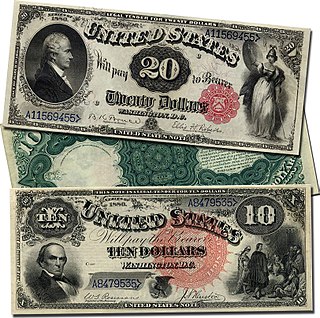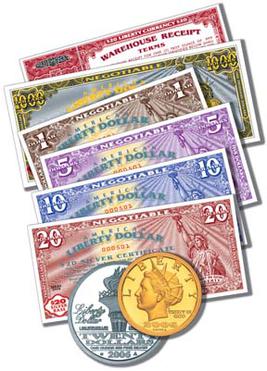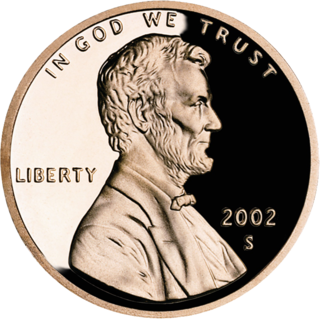Save the Greenback is an organization of U.S. Bureau of Engraving and Printing employees and paper and ink suppliers opposed to phasing out the paper dollar. [1] The group formed to counter the influence of the Coin Coalition. [2] Their website was inactive as of July 2012.
Public opinion has tended to favor the dollar bill, although in 2000, the Government Accountability Office reported that a full implementation of the dollar coin could save $500 million a year. [3]
There was an online organization calling itself Americans for George. It was a public-relations campaign appearing to be a grassroots organization (an "Astroturf group"). [4] Their website was also inactive as of July 2012.
In 2006 and 2007, auto manufacturer Kia Motors used this name in a car discount campaign. In the TV campaigns, the group was portrayed as a group similar to Greenpeace, with a mission to save money. [5] [6]

The Canadian dollar is the currency of Canada. It is abbreviated with the dollar sign $. There is no standard disambiguating form, but the abbreviations Can$, CA$ and C$ are frequently used for distinction from other dollar-denominated currencies. It is divided into 100 cents (¢).
Federal Reserve Notes are the currently issued banknotes of the United States dollar. The United States Bureau of Engraving and Printing produces the notes under the authority of the Federal Reserve Act of 1913 and issues them to the Federal Reserve Banks at the discretion of the Board of Governors of the Federal Reserve System. The Reserve Banks then circulate the notes to their member banks, at which point they become liabilities of the Reserve Banks and obligations of the United States.

A United States Note, also known as a Legal Tender Note, is a type of paper money that was issued from 1862 to 1971 in the United States. Having been current for 109 years, they were issued for longer than any other form of U.S. paper money other than the currently issued Federal Reserve Note. They were known popularly as "greenbacks", a name inherited from the earlier greenbacks, the Demand Notes, that they replaced in 1862. Often termed Legal Tender Notes, they were named United States Notes by the First Legal Tender Act, which authorized them as a form of fiat currency. During the early 1860s the so-called second obligation on the reverse of the notes stated:
This Note is a Legal Tender for all debts public and private except Duties on Imports and Interest on the Public Debt; and is receivable in payment of all loans made to the United States.

Legal tender is a form of money that courts of law are required to recognize as satisfactory payment for any monetary debt. Each jurisdiction determines what is legal tender, but essentially it is anything which when offered ("tendered") in payment of a debt extinguishes the debt. There is no obligation on the creditor to accept the tendered payment, but the act of tendering the payment in legal tender discharges the debt.

The dollar coin is a United States coin with a face value of one United States dollar. Dollar coins have been minted in the United States in gold, silver, and base metal versions. Dollar coins were first minted in the United States in 1794.

The United States one-hundred-dollar bill (US$100) is a denomination of United States currency. The first United States Note with this value was issued in 1862 and the Federal Reserve Note version was first produced in 1914. Inventor and U.S. Founding Father Benjamin Franklin has been featured on the obverse of the bill since 1914, which now also contains stylized images of the Declaration of Independence, a quill pen, the Syng inkwell, and the Liberty Bell. The reverse depicts Independence Hall in Philadelphia, which it has featured since 1928.

The United States one-dollar bill (US$1), sometimes referred to as a single, has been the lowest value denomination of United States paper currency since the discontinuation of U.S. fractional currency notes in 1876. An image of the first U.S. president (1789–1797), George Washington, based on the Athenaeum Portrait, a 1796 painting by Gilbert Stuart, is currently featured on the obverse, and the Great Seal of the United States is featured on the reverse. The one-dollar bill has the oldest overall design of all U.S. currency currently being produced. The reverse design of the present dollar debuted in 1935, and the obverse in 1963 when it was first issued as a Federal Reserve Note.

The North American monetary union is a theoretical economic and monetary union of three North American countries: Canada, Mexico, and the United States.

The American Liberty Dollar (ALD) was a private currency produced in the United States.
The Coin Coalition is an organization supporting the elimination of pennies and one dollar bills from U.S. currency. It is funded by vending machine companies, video-arcade owners, and the soft-drink industry, who all have an interest in eliminating maintenance costs associated with bill validators. The National Bulk Vendors Association supports the Coalition.

Counterfeit money is currency produced outside of the legal sanction of a state or government, usually in a deliberate attempt to imitate that currency and so as to deceive its recipient. Producing or using counterfeit money is a form of fraud or forgery, and is illegal in all jurisdictions of the world. The business of counterfeiting money is nearly as old as money itself: plated copies have been found of Lydian coins, which are thought to be among the first Western coins. Before the introduction of paper money, the most prevalent method of counterfeiting involved mixing base metals with pure gold or silver. Another form of counterfeiting is the production of documents by legitimate printers in response to fraudulent instructions. During World War II, the Nazis forged British pounds and American dollars. Today, some of the finest counterfeit banknotes are called Superdollars because of their high quality and imitation of the real US dollar. There has been significant counterfeiting of Euro banknotes and coins since the launch of the currency in 2002, but considerably less than that of the US dollar.

Free silver was a major economic policy issue in the United States in the late 19th century. Its advocates were in favor of an expansionary monetary policy featuring the unlimited coinage of silver into money on-demand, as opposed to strict adherence to the more carefully fixed money supply implicit in the gold standard. Free silver became increasingly associated with populism, unions, and the perceived struggle of ordinary Americans against the bankers, monopolists, and robber barons of the Gilded Age. Hence, it became known as the "People's Money".
The history of the United States dollar began with moves by the Founding Fathers of the United States of America to establish a national currency based on the Spanish silver dollar, which had been in use in the North American colonies of the Kingdom of Great Britain for over 100 years prior to the United States Declaration of Independence. The new Congress's Coinage Act of 1792 established the United States dollar as the country's standard unit of money, creating the United States Mint tasked with producing and circulating coinage. Initially defined under a bimetallic standard in terms of a fixed quantity of silver or gold, it formally adopted the gold standard in 1900, and finally eliminated all links to gold in 1971.
The Save the Greenback Act was legislation proposed, but not passed, in the United States Congress in 1995 and 1997 forbidding the phase-out of the United States one-dollar bill.

Early American currency went through several stages of development during the colonial and post-Revolutionary history of the United States. John Hull was authorized by the Massachusetts legislature to make the earliest coinage of the colony in 1652.

A debate exists within the United States government and American society at large over whether the one-cent coin, the penny, should be eliminated as a unit of currency in the United States. The penny costs more to produce than the one cent it is worth, meaning the seigniorage is negative – the government loses money on every penny that is created. Several bills introduced in the U.S. Congress would have ceased production of pennies, but none have been approved. Such bills would leave the five-cent coin, or nickel, as the lowest-value coin minted in the United States.

Greenbacks were emergency paper currency issued by the United States during the American Civil War that were printed in green on the back. They were in two forms: Demand Notes, issued in 1861–1862, and United States Notes, issued in 1862–1865. A form of fiat money, the notes were legal tender for most purposes and carried varying promises of eventual payment in coin but were not backed by existing gold or silver reserves.

The United States dollar is the official currency of the United States and several other countries. The Coinage Act of 1792 introduced the U.S. dollar at par with the Spanish silver dollar, divided it into 100 cents, and authorized the minting of coins denominated in dollars and cents. U.S. banknotes are issued in the form of Federal Reserve Notes, popularly called greenbacks due to their predominantly green color.

Fiat money is a type of currency that is not backed by a precious metal, such as gold or silver, or backed by any other tangible asset or commodity. Fiat currency is typically designated by the issuing government to be legal tender, and is authorized by government regulation. Since the end of the Bretton Woods system in 1971, the major currencies in the world are fiat money.
The United States $1 Coin Act of 1997 was legislation passed by the United States Congress providing for a redesigned gold colored coin with a distinctive new rim. A major purpose of the Act was to allow for the replacement of the Susan B. Anthony dollar. The stockpiles of that coin had been depleted to the point that minting new coins would soon be required. The Sacagawea dollar was introduced as a result of the Act.